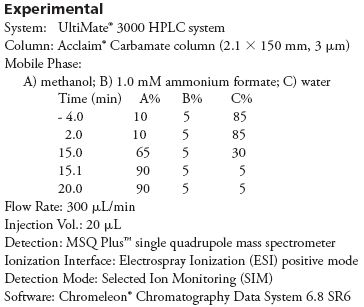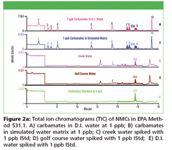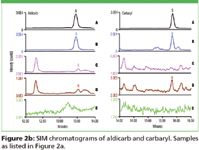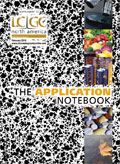N-Methyl Carbamates in Water
N-methyl carbamates (NMCs) are widely used as pesticides and have been reported in the environment and food.
Leo (Jinyuan) Wang and William C. Schnute, Dionex Corporation
N-methyl carbamates (NMCs) are widely used as pesticides and have been reported in the environment and food. They are endocrine disruptors that exert an anticholinesterase action on the nervous system. N-methyl carbamates are relatively unstable compounds that breakdown in the environment fairly rapidly.
This application describes a routine LC–MS method for direct analysis of sub-ppb level NMCs in water samples without lab-intensive sample enrichment, excessive sample preparation, or derivatization.

A standard pesticide mixture containing 10 carbamates was diluted into methanol as a working solution to prepare calibration standards. Calibration standards were prepared by series dilutions of the working solution to 10 ppb, 5 ppb, 1 ppb, 0.5 ppb, 0.2 ppb, 0.1 ppb, and 0.05 ppb with IStd (isotope-labeled carbaryl-d7) spiked at 1 ppb at each level.
A MSQ Plus single quadrupole mass spectrometer was used in this study to provide sensitive and selective detection. Although triple quadrupole MS/MS instrumentation offers better selectivity by using selected reaction monitoring (SRM) mode, the single quadrupole was selected here due to its adequate sensitivity, ease-of-use, and lower cost, thus making it more suitable for routine analysis.
When no buffer was added to the mobile phase, NMCs were observed as protonated molecular ion ([M+H]+) or adducts ([M+NH4]+ and [M+Na]+). Ammonium formate buffer (0.05 mM) was added to the mobile phase to facilitate the formation of analyte-ammonium adducts to improve the sensitivity for some analytes. SIM scan parameters for each analyte are shown in Table I. The fragment ion of methiocarb was selected for quantification due to the interference observed when using the molecular ion as a quantitative ion, thus ensuring method specificity.

Table I: SIM Scan Events for Carbamates
Results and Discussion
The improved chromatographic performance is seen in Figure 1. Ten target analytes were separated to baseline in less than 18 min with MS detection providing enhanced selectivity and sensitivity. Method detection limit (MDL) was calculated by seven replicate injections of a standard at 0.5 ppb and calculated by the equation: MDL = S × t(99%, n=7) where S is the standard deviation and t is the Student's t at 99% confidence interval. Sub-ppb level MDL was achieved for each analyte from 0.017 (3-hydroxycarbofuran) to 0.059 ppb (methiocarb). Limit of quantification (LOQ) was determined as the lowest concentration in the calibration standards that shows signal-to-noise ratio > 5. The LOD for this method was <50 parts-per-trillion (ppt) for each analyte except for aldicarb sulfoxide (0.20 ppb). Linear correlation was achieved for each analyte with correlation of determination (r2) greater than 0.999 except for methiocarb (r2 = 0.9966) through the calibration range exceeding two orders of magnitude (LOQ to 10 ppb). Better r2 (r2 = 0.9998) was obtained for methiocarb using quadratic fitting and was used for quantification.

Figure 1
This method was successfully applied to analyze water samples collected from sources possibly containing trace-levels of NMC. Without sample enrichment, the water samples were analyzed directly after filtration and spiking IStd at 1 ppb. No NMC was observed in the well water and in the golf course influx water; only aldicarb was detected in the rural creek water sample at a very low level (0.12 ppb); aldicarb was detected in the water from the golf course water hazard under LOQ (calculated at 0.08 ppb) and carbaryl was also detected in this water sample under LOQ (calculated at 0.04 ppb). Figure 2a shows the overlay of TIC chromatograms for 1 ppb NMC spiked D.I. water and simulated matrix, a creek water sample, a golf course water hazard sample, and a lab blank sample all spiked with 1 ppb IStd. Figure 2b shows the SIM chromatograms of aldicarb and carbaryl.

Figure 2a
Conclusions
This work presents an improved LC–MS method for routine trace-level analysis of 10 U.S. EPA specified N-methyl carbamates in water samples. Sub-ppb level N-methyl carbamates in water samples can be analyzed directly after simple filtration. This work also demonstrates trace-level carbamate quantification in real water samples.

Figure 2b
Acclaim and UltiMate are registered trademarks of Dionex Corporation.
MSQ Plus is a trademark of Thermo Fisher Scientific, Inc.

Dionex Corporation
1228 Titan Way, P.O. Box 3603, Sunnyvale, CA 94088
tel. (408)737-0700; fax (408)730-9403
Website: www.dionex.com

Separation of Ultra-Short and Long Chain PFAS Compounds Using a Positive Charge Surface Column
December 11th 2024A separation of ultra-short and long chain PFAS (C1-C18) is performed on a HALO®PCS Phenyl-Hexyl column along with a HALO®PFAS Delay column which demonstrates excellent retention for both hydrophilic and hydrophobic analytes.















